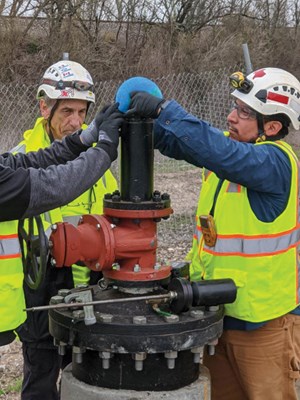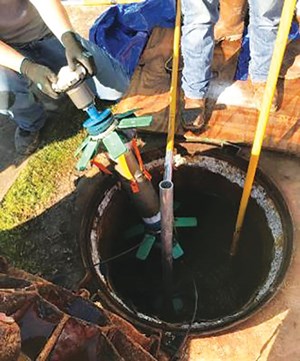December 2021 Vol. 76 No. 12
Rehab Technology
Pipe Check: Using Force Main Inspections to Keep Wastewater Flowing
By Lauren Kubin, P.E,. North Texas Municipal Water District, Mazen Kawasmi, P.E., CFM, GISP, and Stephen Johnson, PE, Freese and Nichols, Inc., Stacie Sandmann, Pure Technologies
The North Texas Municipal Water District (NTMWD) serves 1.8 million residents in a fast-growing, 10-county area. That means maintaining 710,000 linear feet of gravity pipelines to provide wastewater treatment that can surpass 151 million gallons per day. Keeping an aging system operating without interruption is an ongoing challenge.
To assess the condition of pipe segments, NTMWD uses multisensory inspection – HD CCTV, sonar and laser technology – that provides data to inform long- and short-term rehabilitation decisions. The District can determine which segments need immediate repair or replacement, avoiding catastrophic environmental impacts and maintaining the system at peak performance.
Inspections of NTMWD’s Lower White Rock Creek force mains in 2020 illustrate how partnering with experienced consultants using state-of-the-art technology helped improve its decision making about capital investments to reduce risk, improve the system’s operations and maximize the value of its rehabilitation budgets.
The challenge
NTMWD has committed to inspecting at least 10 percent of its wastewater system gravity pipelines each year on a 10-year cycle and following up with repair, rehabilitation or replacement, depending on the findings. As part of this proactive approach, the District also is working to inspect its force mains. In 2020, that included the Lower White Rock Creek and Lower White Rock Creek Parallel Force Mains due to their critical nature and previous maintenance issues.
The 16-inch-diameter, 12,495-linear-foot Lower White Rock Creek Force Main and 24-inch-diameter, 12,496-linear-foot White Rock Creek Parallel Force Main Expansion converge into
a single 27-inch-diameter, 1,620-linear-foot force main.
Consisting of bar-wrapped pipe, the force mains transfer wastewater from the Lower White Rock Creek Lift Station to a junction box near a major roadway interchange surrounded by a private high school, residential developments and an array of businesses, in Plano, Texas, north of Dallas. A separate line from the Mapleshade Lift Station, owned by the city of Plano, an NTMWD member city, also feeds into the 24-inch force main.
The purpose of the inspections was to identify potential leaks, gas pockets or broken bar wraps. Leaks can signal that pipe segments are about to fail. Gas pockets can cause multiple problems, such as a pipe collapse from a wastewater surge, interfering with the flow, or corroding the pipes if hydrogen sulfide builds up. Long-term leaks can corrode and weaken the bar-wrapped pipe.
Project approach
The force main inspections are an essential part of a broader Condition Assessment Program (CAP) that included gravity main and manhole inspections, and recommendations for rehabilitation or replacement as needed.
The inspection approach included:
- A site visit by the project team to evaluate the force main, associated lift station and downstream discharge structure
- Analysis of condition assessment field data
- Incorporation of results and ratings into the overall CAP
- Maintenance of the GIS database, with corrections provided to the District’s GIS staff for merging into the overall geodatabase
As part of the pre-inspection coordination, the team evaluated the suitability of the existing infrastructure to deploy the inspection equipment. It was determined that the 16-inch force main did not have a suitable insertion location, so the NTMWD installed a new wye connection on the force main.
Inspection technology
A SmartBall inspection looked for leaks and gas pockets along the 16-inch Lower White Rock Creek Force Main and 24/27-inch White Rock Creek Parallel Force Main Expansion. SmartBall technology provides a nonintrusive pipe inspection, collecting acoustic and sensor data that can be evaluated to determine if any of these three problems can be identified:
- Entrained Air, or small, moving bubbles of gas
- Slugs, which are developing gas pockets that can be stationary or migrate
- Fully Developed Gas Pockets, typically occurring at localized high points along a pipeline
A PipeDiver electromagnetic inspection conducted over three weeks covered a cumulative distance of 5 miles between the White Rock Creek Lift Station and the junction box to locate pipes with broken reinforcing bar wraps and wall loss in the steel cylinder.
The inspection revealed that the force mains are in overall good condition. Approximately 98 percent of them showed no signs of distress during the inspection, which is typical for this type.
SmartBall inspection results included the following:
- Lower White Rock Creek Force Main (16-inch) showed no leaks, five gas pockets, five gas slugs, and 12 instances of entrained air.
- White Rock Creek Parallel Force Main Expansion (24-inch) revealed one instance of entrained air.
The PipeDriver electromagnetic inspection results included:
- Lower White Rock Creek Force Main showed three pipes with localized cylinder anomaly and six with nonlocalized cylinder anomaly.
- White Rock Creek Parallel Force Main Expansion (24-inch) had five broken bar wraps and two locations of suspected cylinder wall loss.
- 27-inch pipe showed five broken bar wraps.
Recommendations, Path Forward
As a result of the inspections, the team recommended pipe segment replacement for broken bar wraps and where localized anomalies indicated suspected cylinder wall loss. Air release valves (ARVs) were recommended to deal with the gas pockets, and a surge analysis was suggested to confirm the location where ARVs were needed.
NTMWD has programmed these recommendations into its capital planning budget to address the condition of the force main proactively. Also, additional force main inspections were scheduled, plus two more in May 2021, with the results and recommendations expected by the end of 2021. •
ABOUT THE AUTHORS:
Lauren Kubin, P.E., is a Wastewater Conveyance Engineer with the North Texas Municipal Water District. (469) 626-4923, LKubin@ntmwd.com
Mazen Kawasmi, P.E., CFM, GISP, is a Principal/Vice President in the Water/Wastewater Master Planning Group at Freese and Nichols. (817) 735-7432, Mazen.Kawasmi@freese.com
Stephen Johnson, P.E., is a Senior Project Manager of the Water/Wastewater Master Planning Group at Freese and Nichols. (817) 735-7375, stephen.johnson@freese.com
Stacie Sandmann is a Project Manager at Pure Technologies. (469) 261-7823, Stacie.Sandmann@xylem.com






Comments